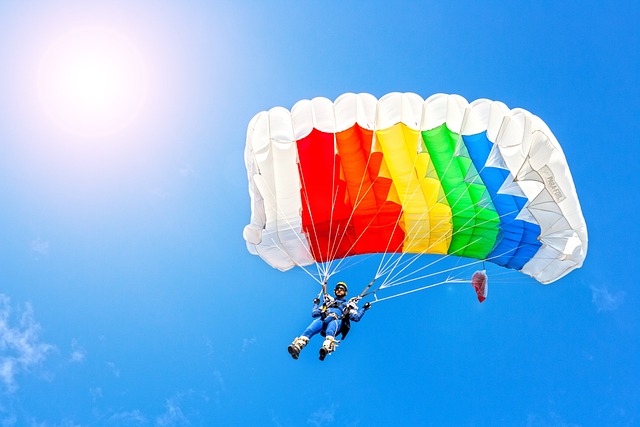Paramotoring has become an increasingly popular adventure sport for those who want to experience the freedom of flight. As a blend of paragliding and powered flight, paramotors provide pilots with the ability to soar through the sky with relative ease. However, as with any aerial activity, safety must always be a top priority. One aspect of safety that often comes into question is the use of reserve parachutes in paramotoring.
Paramotors can be equipped with reserve parachutes for enhanced safety during flights. Although not always legally required, carrying a reserve parachute is highly recommended for pilots to mitigate risks and be prepared for potential emergencies. Proper training, maintenance, and familiarity with deployment are essential for effective use in emergency situations.
In this blog post, I will explore the importance of reserve parachutes, discuss whether paramotors have reserve parachutes, and provide guidance on how to choose, install, and deploy a reserve parachute for your paramotor setup.
What is a Reserve Parachute?
A reserve parachute is a secondary, backup parachute designed to be used in emergencies when the primary canopy, in this case, the paramotor wing, malfunctions or fails to provide a safe descent. The purpose of a reserve parachute is to ensure the safety of the pilot by allowing them to land safely in the event of an unexpected issue with their primary flying equipment.
Reserve parachutes play a crucial role in various aerial sports and activities, including paragliding, skydiving, and paramotoring. They are typically packed separately from the main wing or parachute and are designed to be deployed quickly and easily when needed.
There are different types of reserve parachutes available, each with its own advantages and specific use cases. Some common types include:
- Round reserve parachutes: Traditional and simple in design, these parachutes provide a stable descent but may not offer the best steering capabilities.
- Square reserve parachutes: These offer better control and steering during descent, allowing pilots to better navigate to a safe landing area.
- Hybrid reserve parachutes: Combining the best of both round and square designs, these parachutes offer increased stability and steering control, providing pilots with a more comfortable descent in emergencies.
Regardless of the type, reserve parachutes are an essential piece of safety equipment for pilots engaged in aerial sports, ensuring they have a reliable backup option in case of an emergency.
Do Paramotors Have Reserve Parachutes?
Paramotors, as a piece of equipment, do not inherently come with reserve parachutes. However, many paramotor pilots choose to have a reserve parachute as part of their safety gear when flying. The decision to use a reserve parachute in paramotoring is typically based on factors such as personal risk tolerance, flying experience, and the specific conditions or locations where they fly.
While not legally mandated in all jurisdictions, carrying a reserve parachute is highly recommended for paramotor pilots, as it provides an additional layer of safety in case of equipment failure, turbulence, or other in-flight emergencies. Having a reserve parachute can make a significant difference in ensuring a safe outcome during unforeseen situations.
Although paramotors don’t inherently have reserve parachutes, it is common practice and strongly advised for pilots to equip themselves with one for added safety and peace of mind during their flights.
The role of reserve parachutes in paramotoring
The role of reserve parachutes in paramotoring is primarily to provide an additional layer of safety and security for pilots during their flights. Reserve parachutes serve as a backup system that can be deployed in emergencies when the main wing malfunctions or becomes unstable, allowing the pilot to descend safely to the ground. The key roles of reserve parachutes in paramotoring include:
- Emergency Backup: The primary role of reserve parachutes is to act as an emergency backup in case the main paramotor wing fails or encounters a problem that cannot be resolved while in the air. This can include scenarios such as wing collapses, line twists, or irrecoverable spirals.
- Increased Confidence: Equipping a paramotor with a reserve parachute can give pilots increased confidence in their safety gear, allowing them to focus on enjoying their flights and improving their skills without constantly worrying about potential emergencies.
- Handling Unforeseen Circumstances: During paramotor flights, pilots may face unforeseen circumstances, such as extreme turbulence or sudden changes in weather conditions. A reserve parachute provides a safety net in such situations, giving pilots a viable option to manage the risk and land safely.
- Legal Compliance: In some jurisdictions, carrying a reserve parachute while paramotoring may be mandated by law or strongly recommended by local authorities. In these cases, having a reserve parachute not only enhances safety but also ensures compliance with regulations.
- Training and Education: As pilots progress in their paramotoring journey, they may choose to participate in advanced training, including reserve parachute deployment exercises. This helps them become more familiar with emergency procedures and better prepared to handle real-life situations that may require the use of a reserve parachute.
Carrying a reserve parachute can make a significant difference in ensuring the best possible outcome when faced with unexpected challenges during a paramotor flight.
Why do some paramotor pilots choose to have a reserve parachute?
Some paramotor pilots choose to have a reserve parachute as part of their safety gear for various reasons. The decision to carry a reserve parachute is generally based on personal preferences, risk tolerance, and specific flying conditions or locations. Here are some key reasons why paramotor pilots may choose to have a reserve parachute:
Enhanced Safety
The most obvious reason for carrying a reserve parachute is to ensure a higher level of safety during flights. In case of an equipment malfunction, unexpected turbulence, or other in-flight emergencies, a reserve parachute can be a lifesaver, providing pilots with a means to descend safely to the ground.
Risk Mitigation
Paramotoring, like any other aerial sport, comes with inherent risks. Carrying a reserve parachute helps mitigate these risks by providing pilots with a backup system that can be deployed if the main wing becomes unstable or unusable.
Confidence and Peace of Mind
Knowing that they have a backup system in place can give pilots greater confidence and peace of mind during flights, allowing them to focus on enjoying the experience and improving their skills without constantly worrying about potential emergencies.
Legal Requirements
In some locations, it may be legally required or strongly recommended by local authorities to carry a reserve parachute while paramotoring. In these cases, having a reserve parachute ensures compliance with regulations and demonstrates a commitment to safety.
Flying in Challenging Conditions
Pilots who frequently fly in areas with unpredictable weather, strong winds, or turbulence may choose to carry a reserve parachute to be better prepared for potential emergencies that could arise from such conditions.
Experience Level
Beginner pilots may choose to carry a reserve parachute as an added safety measure while they are still learning and developing their skills. Likewise, experienced pilots who engage in advanced maneuvers or fly in challenging environments may also opt for a reserve parachute to minimize risks.
Ultimately, the decision to carry a reserve parachute in paramotoring is a personal choice based on a pilot’s individual risk tolerance, flying habits, and the specific conditions they encounter. Carrying a reserve parachute can provide an additional layer of safety, increased confidence, and peace of mind for pilots during their flights.
Factors to consider when deciding to use a reserve parachute for paramotoring
When deciding whether to use a reserve parachute for paramotoring, there are several factors that pilots should consider to make an informed decision. Here are some key factors to take into account:
Personal Risk Tolerance
Each pilot has a different level of risk tolerance, and it’s essential to assess your comfort level with the inherent risks associated with paramotoring. If having a reserve parachute provides you with a greater sense of security and confidence during flights, it may be a worthwhile addition to your safety gear.
Experience Level
Your skill and experience as a paramotor pilot can play a role in your decision to use a reserve parachute. Beginner pilots may benefit from the added safety measure, while more experienced pilots may feel comfortable without one. However, even experienced pilots may choose to carry a reserve parachute when performing advanced maneuvers or flying in challenging conditions.
Flying Conditions and Locations
The specific conditions and locations where you fly can also influence your decision to use a reserve parachute. If you frequently fly in areas with unpredictable weather, strong winds, or turbulence, having a reserve parachute can provide added safety and peace of mind.
Legal Requirements
In some jurisdictions, it may be legally required or strongly recommended by local authorities to carry a reserve parachute while paramotoring. Make sure to research the regulations in the area where you’ll be flying and ensure compliance if a reserve parachute is mandated.
Weight and Bulk
Adding a reserve parachute to your paramotor setup will increase the overall weight and bulk of your equipment. Consider whether the additional weight will impact your flight performance or make it more difficult to transport and set up your gear.
Cost
Reserve parachutes can be a significant investment, with prices varying based on the type and brand of the parachute. When deciding whether to use a reserve parachute, consider the financial implications and whether it fits within your budget.
Training and Familiarity
If you decide to use a reserve parachute, it’s essential to receive proper training in its use and deployment. This includes understanding how to deploy the reserve parachute in an emergency and how to maintain and inspect the parachute regularly.
Taking these factors into account will help you make an informed decision about whether to use a reserve parachute for your paramotoring adventures. The ultimate goal is to prioritize safety and ensure that you feel confident and secure during your flights.
How to Choose the Right Reserve Parachute for Your Paramotor
Choosing the right reserve parachute for your paramotor is crucial to ensure optimal safety and performance during your flights. Here are some factors to consider when selecting a reserve parachute that best fits your needs:
- Size and Weight: The size and weight of the reserve parachute should be compatible with your paramotor setup and your weight. Heavier pilots may require a larger reserve parachute with a higher load capacity to ensure a safe descent. Be sure to check the manufacturer’s recommendations for the appropriate size based on your weight and equipment.
- Type of Reserve Parachute: There are various types of reserve parachutes, such as round, square, and hybrid designs. Each type has its own advantages and specific use cases.
- Round reserve parachutes: Traditional and simple in design, these parachutes provide a stable descent but may not offer the best steering capabilities. b. Square reserve parachutes: These offer better control and steering during descent, allowing pilots to better navigate to a safe landing area. c. Hybrid reserve parachutes: Combining the best of both round and square designs, these parachutes offer increased stability and steering control, providing pilots with a more comfortable descent in emergencies.
Personal preferences
Consider your preferences and flying conditions when choosing the type of reserve parachute that’s right for you.
- Brands and Manufacturers: Research reputable brands and manufacturers of reserve parachutes to ensure that you are purchasing a high-quality, reliable product. Read reviews, consult experienced pilots, and seek advice from paramotoring communities to gather recommendations and insights about the best options available.
- Deployment System: Choose a reserve parachute with a deployment system that is easy to use and compatible with your paramotor harness. Some deployment systems may include a handle or a container that attaches to your harness, making it easy to access and deploy the parachute in case of an emergency.
- Inspection and Maintenance: Look for reserve parachutes that are easy to inspect, maintain, and repack. Regular inspection and maintenance are crucial to ensure that your reserve parachute remains in good condition and is ready for use when needed.
- Price: Reserve parachutes come in a wide range of prices, depending on the brand, type, and features. Set a budget for your reserve parachute and compare options within your price range to find the best balance between cost and quality.
By considering these factors, you can make an informed decision and choose the right reserve parachute for your paramotor setup, ensuring optimal safety and performance during your flights.
Installing a Reserve Parachute on Your Paramotor
Installing a reserve parachute on your paramotor is an important step to ensure safety during your flights. Here are the steps and guidelines for properly installing a reserve parachute on your paramotor setup:
Choose a Suitable Mounting Location
The reserve parachute should be mounted in a position that is easily accessible and does not interfere with your flying controls or comfort. Common mounting locations include the side or front of the paramotor harness, depending on the harness design and your personal preferences.
Attach the Reserve Parachute Container:
The reserve parachute is typically stored in a container or deployment bag specifically designed for this purpose. This container should be securely attached to your paramotor harness using the provided straps, buckles, or other attachment systems. Make sure the container is fastened tightly and does not move around during flight.
Connect the Reserve Parachute Bridle
The reserve parachute bridle connects the parachute to your harness and ensures that you remain attached to the parachute during deployment. Attach the bridle to the designated attachment point on your harness, typically found near the main carabiners or at a dedicated reserve attachment point. Ensure that the bridle is free from twists and tangles.
Install the Deployment Handle
The deployment handle is used to release the reserve parachute in case of an emergency. Attach the handle to the reserve parachute container and ensure it is easily reachable during flight. Test the handle to make sure it can be pulled smoothly and without excessive force.
Route the Reserve Parachute Lines
Properly route the reserve parachute lines to prevent tangling or interference with other equipment during deployment. The lines should run smoothly from the reserve parachute container to the deployment handle without any twists or obstructions.
Inspect the Installation
Thoroughly inspect your reserve parachute installation to ensure that all connections are secure, the lines are free from tangles, and the deployment handle is easily accessible. Check that the reserve parachute container does not interfere with your flying controls, seating position, or comfort.
Test Deployment
It is a good idea to practice a simulated deployment of your reserve parachute on the ground to ensure that you are familiar with the process and can deploy it smoothly in case of an emergency. Make sure to repack the reserve parachute correctly after each test deployment.
Remember to regularly inspect and maintain your reserve parachute according to the manufacturer’s recommendations, as proper care is essential to ensure its reliability and effectiveness during an emergency. You can properly install a reserve parachute on your paramotor, enhancing your safety and providing an additional layer of security during your flights, by following these steps and guidelines.
Reserve Parachute Deployment Scenarios and Training
Reserve parachute deployment scenarios and training are crucial aspects of preparing paramotor pilots for emergencies that may arise during their flights. Understanding when and how to deploy a reserve parachute can make a significant difference in the outcome of an emergency. Here are some common scenarios where deploying a reserve parachute may be necessary, along with training recommendations to help pilots become more proficient in handling these situations:
- Wing Collapse: A sudden wing collapse caused by turbulence, extreme weather conditions, or pilot error can lead to an unstable and potentially dangerous situation. In such cases, if the pilot is unable to regain control of the wing quickly, deploying the reserve parachute may be the safest option.
- Irrecoverable Spiral or Spin: An irrecoverable spiral or spin may occur due to pilot error, equipment malfunction, or turbulent conditions. If the pilot cannot regain control of the wing and stop the spin, deploying the reserve parachute may be necessary to avoid a high-speed impact with the ground.
- Line Twists or Tangles: Line twists or tangles can cause a loss of control and may lead to an unstable or unresponsive wing. If the pilot cannot resolve the issue in a timely manner, deploying the reserve parachute can help ensure a safe descent.
- Mid-Air Collision: A mid-air collision with another pilot, an obstacle, or a bird can lead to severe damage to the wing or a complete loss of control. In such cases, deploying the reserve parachute is often the best course of action to minimize the risk of injury.
Training Recommendations:
- Ground Training: Before practicing reserve parachute deployment in the air, pilots should undergo thorough ground training to familiarize themselves with the deployment process, including how to locate and pull the deployment handle, and how to maintain a stable body position during the descent.
- Simulated Deployment: Pilots should practice simulated reserve parachute deployments on the ground to become more comfortable with the process and ensure that they can perform the necessary actions quickly and efficiently during an emergency.
- Supervised Training Flights: Participating in supervised training flights with an experienced instructor can help pilots gain valuable experience and guidance in handling various emergency scenarios. This can include practicing emergency maneuvers and discussing potential reserve parachute deployment situations.
- SIV Courses: SIV courses are designed to teach pilots how to handle specific in-flight emergency situations, such as wing collapses, spins, and line twists. These courses often include practical training on reserve parachute deployment and can be invaluable in preparing pilots for real-life emergencies.
By participating in comprehensive reserve parachute training and understanding the various deployment scenarios, paramotor pilots can greatly improve their ability to handle emergency situations and ensure their safety during flights.
Frequently Asked Questions about Reserve Parachutes and Paramotors
As pilots often have questions and concerns about reserve parachutes and their use, I have compiled a list of frequently asked questions to help clarify their role, selection, installation, and deployment in paramotoring.
Is it mandatory to have a reserve parachute for paramotoring?
Although not legally required in all jurisdictions, having a reserve parachute is highly recommended for paramotor pilots. Some countries or local authorities may have specific regulations mandating the use of reserve parachutes, so it’s essential to research the rules in the area where you plan to fly.
How often should I inspect and repack my reserve parachute?
It’s generally recommended to inspect and repack your reserve parachute at least once a year or according to the manufacturer’s guidelines. Regular inspection and maintenance ensure that your reserve parachute remains in good condition and is ready for use when needed.
Can I deploy my reserve parachute while my paramotor engine is still running?
It is possible to deploy your reserve parachute with the engine running, but it’s generally advised to shut off the engine before deploying the reserve to minimize the risk of entanglement, damage, or injury.
How long does it take to deploy a reserve parachute?
The time it takes to deploy a reserve parachute can vary depending on factors such as the type of reserve, the deployment method, and the pilot’s experience. Generally, reserve parachutes can be deployed within a few seconds, but it’s crucial to practice and become familiar with the deployment process to ensure a quick and smooth deployment during an emergency.
How do I know if my reserve parachute is the right size for me?
The appropriate size of a reserve parachute depends on your total suspended weight, which includes your body weight, the weight of your paramotor, and any additional gear. Check the manufacturer’s recommendations for the appropriate size based on your total suspended weight to ensure a safe and controlled descent.
Can I use a reserve parachute that is designed for paragliding with my paramotor?
Yes, most reserve parachutes designed for paragliding can also be used with paramotors, as they typically have similar attachment points and deployment systems. However, it’s crucial to ensure that the reserve parachute is compatible with your paramotor harness and has a sufficient load capacity for your total suspended weight.
How do I learn to deploy and use my reserve parachute safely?
To learn how to deploy and use your reserve parachute safely, it’s essential to receive proper training from a qualified instructor or attend a specialized course, such as an SIV course. Practicing simulated deployments on the ground and participating in supervised training flights can also help you become more proficient and confident in using your reserve parachute during an emergency.
Conclusion
In conclusion, reserve parachutes play a critical role in enhancing the safety of paramotor pilots during flights. While not always legally required, carrying a reserve parachute is highly recommended for pilots who want to mitigate risks and be prepared for potential emergencies. Understanding different deployment scenarios, undergoing proper training, and regularly inspecting and maintaining the reserve parachute is essential to ensure its effectiveness during an emergency.
When selecting a reserve parachute for your paramotor, consider factors such as size, weight, type, and compatibility with your harness. Installing a reserve parachute properly and familiarizing yourself with its use can provide an added layer of safety and peace of mind during your paramotoring adventures.
Remember that the decision to carry a reserve parachute is ultimately a personal choice based on your individual risk tolerance, flying habits, and specific conditions. By being informed and prepared, you can make the best decision for your safety and enjoyment of the sport of paramotoring.
You might be interested in reading this article next: Can You Fly A Paramotor Anywhere?










